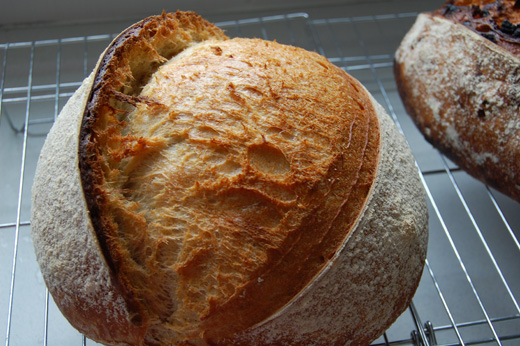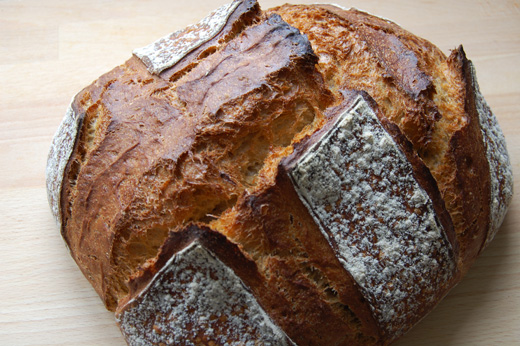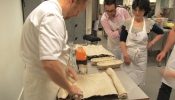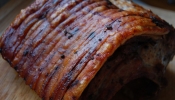This post is the half to the rather detailed one I wrote on how to maintaing and control a healthy starter and balance its acidity, Cycle of Sourdough Starter Part I.
Here I wanted to show from the beginning of making my own starter back in November 2010 using Dan’s recipe, a very easy one to start up and matures quickly, to my present experiments with it. By time I decided to give life to my own sourdough baby I was already an experienced babysitter after taking in one of Gill’s off-springs and bringing it back to a healthy life. But you see I hadn’t given birth as it were to one of my own, a process let me tell you, highly recommended and wonderfully pain-free.
And here it is below right in the small container, my very own baby starter. And just like a new parent I was nervous of killing it, doing something terribly wrong. I wanted so much to make it flourish and be part of the family.

Going right back to the very beginning of being the guardian of Gill’s starter, I was like many sourdough newbies utterly confused and unclear about feeding schedules and how far apart to leave the feeds but slowly things fitted into place.
Now I would like to share the learning curves I’ve made from observing it, day in, day out. I know its little character and can tell you just by looking at it depending on the time of year we’re in, where this little baby is in its cycle. I know if it’s only been fed a couple of hours or 8-12 hrs or 24hrs, importantly when it has run out of ‘umph’ and is crying for food because I’ve missed a feed.

My Starter
The photographs have been collected as I’ve remembered over the last year, that’s why you’ll see different containers. I always feed my starter the same, double the amount of water and flour to the amount of old starter, so 50g starter will be fed 100g water / 100g flour. I always use white bread flour.
I always keep my starter at room temperature on top of my kitchen surface. In the winter it’s unheated and it’s a problem to get it going, this winter because I’ll be baking so much more than previous years I’m going to find it a warmer corner in the house to speed up the cycle.
After Feeding
On a day like today, 15C / 59F, after 2-3 hrs feeding, a few little holes will start to appear.

1
A few hours after that there’s volcanic action going on, it’s bubbling like mad, and bursting bubbles right in front of your eyes…I’ve even video it once…well…it was quite amazing seeing it for the first time.
Can you see below that big bubble right in the middle? Well that’s what I’m talking about popping, some big, some small all popping, it’s very active.

2
At this point it’s in its height of activity. If you try and divide some up you’ll find it fights with you. It’s so thick and sticky that trying to weigh 50g of it will end up more than you want in your scales, as a mass of it attaches onto itself.

3
Can you see what I mean here, thick, gloopy, sticky, full of bubbles underneath.


4
Picking a little up with a spoon becomes a challenge as a whole mass of it wants to come along for the ride.
This is where most of the time I’ll use my starter, but I’m not fanatical about it. Depending on the time of year and how warm it is, this stage can happen in 6-10 hrs but much longer in the cold winter months.

5
Below appears to be at it’s peak but it’s not. You can see lots of bubbles for sure but they’re slightly different, there’s a lot more of what I call “frothy” bubbles and they lie closely together in groups and rise themselves quite above the surface of the rest of the starter.

6
Easier to see in this photo, the ‘frothy’ bubbles.

7
Sometimes when you lift your lid at this stage you’ll notice so many of these “frothy” bubbles and you may even have the whole surface covered in them but it’s not what I describe above with the ‘volcanic’ stage of bubbling up through the surface of the starter and popping slowly.
Most of these frothy bubbles will pop and disappear shortly after you’ve opened the lid and leave the surface with lots and lots of little holes.
There’s still plenty of activity here but on the edge of the peak going down….after this it’s a quick downhill.

8
One of the easiest way to tell where in the cycle it is is to put a fork or spoon through it and see how thick and gloopy or runny it is.

9
As I run a fork through this one you’ll see how different it appears from the one with the spoon, it doesn’t fight with you, it’s still fairly thick but it doesn’t all cling together into a mass. It runs much more freely.


10
After this point it rapidly comparatively goes down hill and gets thinner and thinner.

11
From here onwards it starts to settle into the heavy mass of flour at the bottom and the liquid part floating on top of it. It will stay like that with the water separating getting darker until you refresh it again.

12
This one with very yellow looking water is about 2-3 days old.

13
The one below is a starter kept in an airtight container for 3 weeks.


14
It has the texture of very wet fine sand. I was expecting it to stink but although there was a strong “sour” smell it wasn’t that smelly really..certainly not vile.
I have yet to do anything with it, my experiment was to feed it once and bake, feed it twice and bake, just to see how strong the bread was and how much strength it had after one feeding of rising the loaf.

15
If you feed your starter with rye or wholemeal flour the process speeds up and I’ve made a reference to this in my Part I post.
12% Protein Flour and 9% Protein Flour Experiment
Below was an experiment I carried out because I noticed something was strange when I was feeding my starter with a new flour I had, you see it’s worth paying attention, a close eye on it.
Below you have 2 white roller milled bread flours, one is 12% protein and the other 9% protein.
I had noticed using my 9% protein flour to feed the starter made it go through its cycle much faster than I was use to. Every time I fed the starter, say the night before, I would go to use it in the morning and it was already on the last legs of the “frothy” stages.
That’s why I did a comparison test. After a few hours the 12% flour showed the ‘volcanic’ signs of irrupting from underneath as expected and the 9% flour was already frothing up.

The 12% protein flour.

And the feel test of pulling away from you and having strength of the ‘mass’.

The 9% protein flour on the other hand was already at the ‘frothy’ stage and thinner and runnier.

Now what I do is if I want the process to happen faster I use the 9% protein flour to feed the starter since I have a sack of it to go through.

The 2 Hour Fed Levain Experiment
I was introduced to the idea of the 2 hour fed levain by the baker Paul Merry who runs Panary Bakery & Courses, a truly lovely, intelligent, generous man, someone who has helped me to explore and grow as a baker. I will post about him soon. Paul uses this method of feeding your starter for 2 hours and then using it in your dough, it follows from a Poilâne practice.
The idea of it being you’re using the levain while it still has all of its energy and therefore will exert it in the dough not before. There is a difference with Paul’s starter and levain as he doesn’t use a roller mill white flour, so if you’ve been paying attention you’ll know that will make a difference. And if I remember correctly he uses a 2 hour levain but the starter is old enough to have flavour and if you see my further experiments below you’ll see it makes a difference.
Back to my experiment….this levain below is about 3 hrs old and you can see little dots of activity and livelyness and it’s thick but runny.

What I noticed about it apart from the obvious power it gave the loaf was producing bigger holes…so…wey hey! all you hole obsessed bakers out there…go for it!
As expected it gave a mild tasting sourdough, too mild perhaps for me, but then I’m using a white starter with white flour. If I were to introduce other flours then the flavour would come more from them, and as already mentioned wholewheat or rye flours works through the cycle much faster so comparatively you’ll have a more mature levain anyway.

I thought the idea of the 2 hour levain was great for anyone like my middle kid who still hates my normal mild sourdough because it’s still ‘sour’. This is a fantastic way of producing bread when you love your white ‘wheat’ flavour and want none of that acidity.
Also on the plus side as a baker it made handling a higher hydration dough much much easier, it kept its shape better, lovely to handle.
Below I’ve experimented further by using a 2 hr fed levain on a 24 hour old starter, and the other was a 10 hour old starter. The result was much more of a strong sourdough flavour come through on the older starter, but the younger starter was easier to handle and hold its shape
This means you can mix and match to add acidity and still use a very young strong levain. It’s all there for us bakers to experiment with.



My advice is go forth and experiment…it’s so much fun.




































{ 35 comments }
This is a really useful set of photos and I will recommend it to any new baker trying to understand the rise and fall of the sourdough. Funnily enough I videod my starter the other day…. Nothing like an obsession to make to do odd things (wink). I was interested in What you write about the two hour levain. I have done the four hour warm temp levain for making panettone, low acidity and high yeast activity, up and down all night, checking temps, alarm set, it definitlly works! must try this two hour one, as OH likes low acidity bread. Anyway great post Azelia !
Thanks Joanna, I’m not alone then in my nerdy video of my starter!
Photos, videos help immensely in things like this. I going to try and fit in as much info as I can in the next couple of months because once the garage is an utility room-come-micro-bakery I don’t think I’ll have the time to spend indepth blogging.
Good luck with your baking business Azelia.
I never realized you could bake with the leaven within 2 hours. Mind you, I use my leaven straight from the fridge, so I am used to things taking a goodly long time on me.
Well darling Gill – I have you to
blamethank for my Sourdough Journey xxDear Azelia,
I left a comment previously, and am now back reading your blog after a while.
This is a great post. I wish I had this when starting out on my sourdough journey. Then again, there’s nothing like learning through trial and error (when I think of all those mistakes I made!!!). But this is really invaluable. I’ve had at least two people asking me about leavens, and I try to describe the various stages as well as possible. Somehow it never occurred to me to take photos (DOH!) but now I will simply refer them to your invaluable blog.
As always I admire your dedication and scientific spirit. By documenting all this, you’re rendering help to many people, I’m sure, who may or may not stop by to thank you.
This also reminds me of sth I wanted to mention to you but forgot when I read your post abt baking baguettes from the Tartine bk. If I remember correctly, you were wondering aloud why he and Hamelman use a different method of raising the leavens, using a very small amt of starter compared to the flour and water. This was also sth I found unusual. Robertson mentions he deliberately uses a young leaven. Conversely, I noticed that his fermentation is quite long, possibly to compensate for that, even though his proofing temperature is relatively high. A bit further down the road, you have answered your own question!
So far I have been using fully mature leavens, not quite daring to use a very young leaven for fear that it wouldn’t work, but seeing your experiment, I now have the confidence to try it for myself.
I would also like to point out that although Hamelman uses a small amt of starter, his approach is different. He expands his leaven in two phases, i.e., he does not dump in all the flour and water at once. So in effect, he is using a mature leaven, just that in his book, he takes you by the hand to expand it in two stages (I just sub my own leaven).
Great work, once again!
This was one of the nicest comments I’ve read W. Thank you so much. So glad you find it useful. I spend all my time on producing posts, I basically have no life…sad person…should get out more obviously…and there have been times in the past I have wondered why bother to carry on with the blog, but now and again I receive comments like yours and realise how much I enjoy helping people along the way of my own learning and sharing the experience.
Fortunately I use google analytics and it does tell me lots of people visit my site everyday and most of the time don’t comment but that’s fine with me we don’t always have the time or remember to. I try now and make a point of commenting whenever I stop by someone else’s work because I know it’s always appreciated or at least I think it is.
I’m not sure if I have answered my own question with the way the American bakers use levain though. I do know it results in less sourdough tang, using one tablespoon of levain to 200g of flour etc but I’m not sure why they chose to do it…as I write this…I pause…think and wonder and remember about my baguettes from Tartine comparing them to my own using my heavy use of levain…
hmmmm…I think what it does apart from the less acidity it actually changes the crumb itself of the dough result…this is what’s coming into my head now as I type…I’m making a connection between the baguette experience and thinking how a normal SD loaf has this slightly ‘waxy’ texture, chewy which is very different from a yeast loaf where it’s more ‘fluffy’ ‘soft’ texture. Though you can manipulate yeast dough to behave and result in texture similar to an SD loaf.
I should do some experiments really..and see the resulting crumb….well that was an interesting thought process you’ve made me do. Thanks W. x
Hi Azelia, I absolutely LOVE your experimental approach and the way you go about things. I feel so inspired to be braver and try different things. Thank you so much for all you do.
Go for it Julia, it’s only four & water…not dangerous…except if making a bomb obviously
dear Azelia,
I meant to ask you, what do you mean by adding a 2hr leaven to a 24h or 10h starter? I know in your SD post Part I, you mentioned that leaven is what you call the final feed to the starter, but I’m a bit confused. What I do is to add flour and water to my one and only starter/leaven, then let it grow. In other words, I’m expanding it. Do you mean that you maintain a starter, then start a separate leaven (letting it grow, in this case, for 2hrs) then add this to your separate starter? I’ve never done that! I’m imaging that bakeries do that for better control and because they work with huge quantities, but what advantage does that give the home baker?
I’m going to have to pluck up my courage to use a young leaven for the Tartine method. I will miss the pronounced SD tang but what’s a bit of experimentation eh (*wink*). It’s also a plus if it makes for easy shaping. Come to think of it, I probably did myself in those rare times when I tried to respect the temperatures and proofing times of Tartine, yet using a fully mature leaven, resulting in a over-developed and proofed dough. I’ll take your word for it that it works ☺
Finally are you saying that your Tartine baguettes lacked that waxy, chewy texture? So far, all the breads I made from Hamelman and Tartine have not been lacking in that (ah how I love a gelatinised crumb…), although it must be said I DO NOT follow their leaven-raising methods. Actually I think it’s all abt means and ends. You start out differently, but like you said, it’s all abt tweaking to get your desired outcome, and being observant abt the dough and responding to it.
But really, do give yourself a pat (and more) on the shoulder for your efforts in this blog. If nothing else, that you even, while trying to do a million and one things in the kitchen (and house), pick up your camera with your flour-covered hands, snap a picture, pick up where you left off, is effort enough! thanks for your reply!
W – just keep feeding your starter the way you do it and don’t worry about the term levain I do the same as you that’s why it becomes confusing, so don’t worry about it.
Before the last feed….say you’re going to make the last feed tomorrow morning for a baking later in the day, don’t feed your starter for 10hrs before that…or 24hrs before that. It means even though you’ll have a “young” starter it will be made on the back of an older starter therefore a more pronounced “tang” flavour than if you feed the starter now then 6hrs later fed it again for last feed. Need to do a time line for this really don’t I? Does that make sense? If you keep on feeding with shorter times in-between the more fresh the starter is therefore less acidic but if you miss a feed just before last feed it will still have some acidity.
Play around – that’s how you’ll learn!
Hi – thank you so much for your informed, helpful writing. I started baking bread in October (having made perhaps 3 loaves in my life before) & declared to my kids that we would stop buying and make it all – so far I’ve stuck to it but I am still a complete novice. Then I went to a Dan Lepard event last week & got talking to someone about sourdough & Dan recommended your site as a really useful resource. In fact, my ONLY resource! Having leapt before I looked, I have carefully followed your SD part 1 instructions and have a completely overflowed starter – I can only assume it is very much alive and ready to bake with.
Stupidly I had assumed I would get this far and then the rest would just fall in to place with the aid of Google and my enthusiasm. Having read more I am somewhat daunted by the options – hydration etc. Bit lost! I hope you don’t mind a couple of questions.
1) Am I right in thinking that I should/could now split my starter – leave the bulk in the fridge & feed every week or so & take 50g? 100g? feed tomorrow morning & bake tomorrow evening with it?
2) If I use say 100g starter, mixed with flour & water as per recipe elsewhere on your blog I follow the usual Dan knead quickly, rest 15 mins x 3, leave for hour-ish then bake for ? long? Or are the timings techniques completely different to my bog-standard white loaf?
3) oh – and does it matter if I mix up whether I feed it with rye flour or strong white – presumably it will change the flavour a bit but otherwise doesn’t matter.
Really appreciate any advice & thanks for such fantastic help so far.
hi Cruby and welcome – there’s a lot of questions or at least a lot of detail to convey across, have a read through this post which I describe my experience from the beginning of baking bread/sourdough:
http://www.azeliaskitchen.net/blog/sourdough-problems-from-my-beginnings/
Some people have the starter as you described in the fridge and take it out to feed it once or twice before using. I’ve never put mine in the fridge, it stays on the kitchen top.
I tend to take some and feed it more than I need in order to keep some for the next feed. For example will take 70gm of starter, feed it 140g water, 140g flour. That will give me enough for 200g of starter for loaf and some leftover for the next feed. You will fall into your own routine as you go, depending how often you bake and how much at a time.
Freeze 100g of starter and date it, will keep for a year, it’s a safety net and will make you feel good knowing you have a back-up.
Sourdough will take longer to prove, doesn’t matter so much on the folds and the time between folds, but if you leave it in a warmish room 20mins at least between folding, but I often wait 30-40mins intervals.
It does matter more on the last proving. Most of the time I leave the last proving in the fridge overnight and bake in the morning, means I’ll have fresh bread first thing. Last proving depending how pressed for time give it 3-5hrs. You can leave it much longer, will give you slightly different crumb. If leaving less will work but you risk the crumb being a bit doughy/heavy. This is all dependant on temperatures, because in a blazing hot summer of 25C say 2hrs would be just perfect!
Personally I like to keep my white a white starter and if making other flours I will take some separately and feed it in different container. Otherwise it will take a few feeds to go back, but that’s only because I keep a white wheat one, I know bakers who will use a rye starter to bake wheat sourdough for the flavour it gives it.
See how you get on.
Oh dear-I am so cofused. I have something in a jar that is doubling every 12-14 hours. it only doubles not triple, or quadruple. But it is consistent. I have been feeding it every day at a 100% formula. i also have another jar started on the same day with a 60% formula. I can see that one works slower than the other. But, now what do I do? Do I continue feeding-it seems to just do the same thing over and over again: up, down,feed, up,down, feed, etc. When does it get really thick with liquid on top. This is my first try at making a sourdough starter. Thank you again,
Anne – have a look at Dan’s recipe here and see where you’re at http://www.azeliaskitchen.net/blog/how-to-make-easy-sourdough-starter-dan-lepard/
It’s impossible to help unless I know what recipe, what flour you’re using and details of how many days you’ve been feeding and the routine of how you feed it.
Dear Azelia:
I am at about day 10! For 2 days I let it sit on the counter without feeding it and it moved along according to your pictures. Last night at 9:40PM I fed it according to your recipe 50g starter 100 g each of flour and water. This morning 0330AM it was tripled, and now at 0500AM it is quadrupled! SOOO now what do I do? Did I feed my starter AND build a levain? Please point me to a good french country style loaf that I can practice on for 10 times! I cannot find a recipe on Dan Lepard’s site. Also, do I now build another levain?
Thank you again,
A
11:50AM update: My starter (levain?) is now more than 4 x’s -I think I must have created a levain from my starter, but I am not certain. Anyway, now I will look for a bread to practice on with my 100% starter. Still hoping you will send a good recipe for beginners such as myself.
Anne – you don’t have to keep on feeding the starter, only when you want to use it for baking, then you need to feed it ideally twice, (at intervals) before mixing into a dough. Your starter can be allowed to go down and dormant for a week if the temperatures aren’t hot.
For a plain white Loaf use Dan Lepard recipe:
200g levain a decent amount of activity (fed in the last 5-12hr depending on cool/hot temp)
500g bread flour
300-320g water (room temperature) precise amount dependant on how strong your flour is and absorbent
8-10g salt
Then follow this method of folding here: http://www.azeliaskitchen.net/blog/walnut-raisin-bread/
Also read this post on problems for beginners http://www.azeliaskitchen.net/blog/sourdough-problems-from-my-beginnings/
If you have any queries let me know…
Dear Alezia: I hope you will be proud of my next moves! I read both of the links you sent me to in your last post. Life has such wonderful coincidences Alezia-I think you will like this one: just yesterday when I went to my local market I tasted a walnut from the one of the measure-yourself plastic containers. Yes, I pulled down the lever and ate two. I knew beforehand that they would probably be stale leftovers from before Christmas. What a surprise and delight -they were so, so fresh and tasted wonderful. I pulled out a baggy and put it under the spout and poured myself a few nuts. Thinking that DH and I would have them with some apples. But then today on one of the links that you sent me to I read your thoughts about nuts, and that loaf looked so wonderful. My bold little girl self said, “no, you probably don’t have enough nuts and besides this is only your first loaf you should just try the simple recipe she gave you.” But, I just couldn’t the more I looked at that wonderful walnut bread, the more I just had to go ahead and try. After all today was the day I had either to bake a loaf or stop trying. I fed my starter again waited till tripled and began the dough for the walnut bread. I believe I put a little too much walnut paste in and a little too much water. But, I did incorporate a little extra dough on the second fold. I have now shaped the loaf and it sits waiting to go in the refrigerator. It is 9:30PM and I will put it in fridge at 10:00PM. I don’t see a lot of rise, but I do see some.
You know Alezia, a long, long time ago my dear mother sent me to swimming lessons. It was a huge round public pool about 1.5 acres. the center was very deep, but around the edges where they gave lessons it was shallow. I took about 4 lessons and still didn’t understand how to swim. Then one day, I got so tired of seeing all those kids swim out to the center of that immense pool and climbing up to the highest diving board. They looked like they were having so much fun. I walked out the shallowest way, I jumped, and I dog paddled, and finally flung myself at the ladder to go up to the landing. I climbed up like a big kid and didn’t have a clue what to do next. I was studying the kids going off the low board. Suddenly the older kid behind me tapped me on the shoulder signaling that I should move up my place in line-my place in the line up to the highest board. My heart jumped, but I refused to let anyone see me be scared. I was shaking inside when I first began the climb up those steps. When I got to the top the water looked so far down! But, then something strange happened-I surrendered to . . . (I am Anglican raised). I walked forward and knew that I could’nt go face down-so I just stepped off. Coming up through 12 feet of bubbling water, I was so alone. Then I remembered all of my lessons and began to swim. Went on to become a quite good scuba diver years later! I tell you all of this so you won’t give up on me and perhaps if you are interested you will be able to understand how I felt today making walnut bread instead of simple. Thank you again so much for your time and teaching! A
Well done Anne for making the walnut loaf, it’s delicious. You may want to read this post on temperatures of sourdough http://www.azeliaskitchen.net/blog/proving-sourdough-in-winter-maxs-loaf/
Dear Azelia:
You would be proud of your teaching skills I think. The walnut loaf was my first try, even though I did not get a lot of lift, did get enough to call it a decent bread and the flavor is sublime!
As soon as that came out of the oven I went all out and tried PR’s recipe for Basic Sourdough in the BBA on page 233. WOW-I GOT LIFT! It is wonderful and the crumb is perfect for us. That is to say that my jaw muscles don’t feel worked out when eating these two little loaves The flavor was really nice for us sweet up front with a good tang at the end. I did not have enough courage to take the loaves out and set them down on the rack in order to brown up the bottom-next time I will. I sure had to fight back the urge to put “just a little” commercial yeast into the mix. Now, I am so glad i didn’t have to do that! There is a wonderful video on You Tube about forming the loaves and that was very helpful for that part. DH took pictures for me, but I don’t know how to send them to you.
Thank you again so much!
Pleased you’re happy with your loaf Anne.
Hi Azelia
I just want to thank you for your wonderful website and for your fabulous posts. You have a way of explaining complicated things in a simple, understandable way (I am not one for big words), whilst injecting a sprinkle of humour.
I am very new to baking (and cooking in general), and have decided to start my journey by learning how to make sourdough bread. Which I now realise is not necessarily the easiest path to take…oh well!. I received a (teaspoon size) starter from a friend of a friend (without any instructions), and was left to fend for myself. Which suits me, as reading manuals is not really my forte anyway! So I added some water and flour to the starter, put it in the oven, and voila – I expected a great sourdough loaf to appear. Needless to say that it didn’t, and I very quickly realised that there is an art to making sourdough bread. So I set out to learn about it, and after a week of trawling the Internet I finally stumbled onto your website – and for the first time someone was talking in a language that I understood!
I probably sound like a complete novice (which I am), but i have now understood the role a starter plays and am in the process of learning how to take care of mine. I am sure there will be many failed sourdough breads in the next couple of months…but I am determined to get to the point where I can make a great sourdough loaf, and I know that with the help of your posts I will get there! So thank you in advance for turning this Cinderella into a Kitchen Princess!
hi IM – I really enjoyed reading your story it made me laugh this morning, I know exactly how the beginning feels.
Feed your starter white bread flour (not stoneground) if you can and get to know its cycle, keep feeding the same flour. Lots of bakers tend to add rye flour or other flours but don’t, there’s no need for it, if you want to add flavour add instead mix of flours to the dough instead. If you have a good starter the bread will happen.
I don’t know where you live but if it’s like here in the UK then you’ll notice a big change between summer & winter and how your starter can take 24hrs to be ready in the winter.
Always feed your starter before baking, it’s when the microbes have new food and have been allowed to multiply do they produce enough carbon dioxide to raise your loaf.
Make sure your mother starter is refreshed continuously, I refresh mine every time I feed, if this doesn’t make sense to you let me know and I’ll explain further.
Hi Azélia
Thank you so much for your response and advise….and I only partially understand what you mean….:-(.
I have organic white flour which I bought at the supermarket – I have no idea whether it is bread flour or stoneground flour though….I did look up the protein content (11.4gr per 100gr) but classified it as interesting information as I am not yet at the stage where I know what to do with that . I also have some organic rye flour which I was adding to the starter, so I’ll stop that.
. I also have some organic rye flour which I was adding to the starter, so I’ll stop that.
So far I added flour and water to the starter (in equal portions) and put half of it in the fridge and half of it in the kitchen. After 20 hrs there does not seem to be much of a difference between both ” trials”. Maybe this is because it is winter here (I live in Australia) and the kitchen is not heated. Both starters have bubbles, but no volcanic eruptions (to quote you). And believe me – I have been on the lookout for them! In fact, I have been staring at my starter a lot, trying to match it to your pictures, and hoping for it to do something (having said that, it is unlikely I would recognise the something if it happened). I thought smelling it might give me better clues – it smells sour-ish, not really pleasant, but not repulsive either. So no hints there! BUT, as I said, it has lots of bubbles underneath (it is a plastic container so I can see them), so something seems to be happening. My plan was to give it some more flour and water in a couple of hours, and maybe repeat that again in 24 hrs. I am hoping that 12h or so after the 3rd feed it will have increased in volume…at which point I was going to follow your sourdough recipe (I did not follow a recipe in my previous attempt – not a good idea!), do your folding-in-the-bowl thing (great pictures – helped me understand eat it means), put it in the oven with some water (as per your recommendation)….-and hopefully have something somewhat edible at the end of this!
Not sure what refreshing the mother means? Is the mother the container i put in the fridge? My intent is to add whatever I have left from the starter on the kitchen bench to the starter in the fridge – is that what you mean? Or does she need something else?
Sorry to have so many questions – I have no clue what I am doing. But I am having a lot of fun. I do not know why (I have resisted cooking my entire life – never appealed to me), but this sourdough journey puts a massive smile on my face, even though it is obvious that I am far from generating a good loaf!
hi IM – OK now I know where you are, what’s the temperature there?
Keep the starter for now out of the fridge this will help to see the cycle better.
Adding rye to your starter will make it appear different from mine and it’s cycle, as mine is 100% wheat flour. The rye will speed the cycle up, and it absorbs more water than wheat making the starter appear different such as making the surface of it appear relatively non-active but in fact most of the activity is happening underneath. For this reason is also a good idea to keep a starter in a semi-seethrough container to enable to check underneath.
At 11% protein you have it seems an all purpose flour rather than a bread flour, not a problem as French bakers use 11% flour because it creates great crust. The only problem is that the water absorption will be less, so hold back 20 grms of water for the first trial to see how you get on. This low protein flour is not the easiest of flour to start with for a beginner, if you carry on struggling think about buying a bread flour just to get you started. Also if you’re not using a proving basket for the sourdough you’ll see the dough most likely spread out on the baking sheet, which case hold the water back next time by another 15grms. By slowing manipulating the dough you’re adjusting to the flour you have, this is a great learning curve which a lot of bakers fail to do.
Follow the steps in my walnut & raisin post for the folding http://www.azeliaskitchen.net/blog/walnut-raisin-bread/
When I refer to the mother I mean the main starter you use, the original. Some people don’t feed the mother for a long time which is wrong it should be refreshed all the time in order to maintain a good home for the bacteria. So as you feed the starter keep some of that “new” starter as your mother starter and next time you’re feeding again you’re using that one, feeding it again, discarding the old one and so on…always discard the old one. If this is what you’re doing then that’s great.
The important thing to remember about the starter is this: It requires feeding with flour to flourish. As soon as the microbes have eaten their way through the new dose of flour it will start going dormant again. It can stay dormant at room temperature for 2-4 days with no harm in warmer temperatures and 5-7 days in colder temperatures but you don’t want to neglect it more than that before feeding again in order to keep a good starter. Some people feed theirs everyday even if they’re not baking but it’s hard if you don’t bake, and there’s no need for it. If you leave it dormant for more than a day you may need to feed it twice before using to bake with, to ensure it’s up and going lively.
Also read through my post from my beginnings http://www.azeliaskitchen.net/blog/sourdough-problems-from-my-beginnings/
Hi Azélia
I really appreciate all your advise….and might need some more ….
When I got up this morning, I took a look at my starter (the one outside of the fridge), fully expecting to see absolutely no change. To my utter surprise my starter had doubled in volume since its last feed, which had been the evening before. I remembered reading somewhere that it is a good thing when your starter has doubled in volume, so I decided it was time to make my second loaf. The result is much better than my first loaf (which to be honest only my twin babies enjoyed – probably because they are teething). But it is far from a yummy loaf, by any stretch of the imagination! I hope you can help me shed some light as to what I might need to do differently….![:-(]()
1) I reduced the water amount, as you suggested. Only I went straight for 290gr of water, wanting to avoid a loaf that spread once it was shaped and waiting to go in the oven (like you I “free-form”). No success – I still ended up with a flat disk of dough
2) the dough was really sticky – quite hard to shape, and extremely hard to do those cuts with a knife – I had to “saw” quite a bit to get some resemblance of a cut.
3) I did the folding… But I do not think I did it correctly. I folded twice in the first hour. Then I did nothing for four hours as I was not at home (I hadn’t planned on my starter doubling). Then when I got back home I folded again twice in an hour. Then I shaped the bread and left it on the baking sheet for 1.5hrs (after which I needed to put it in the oven as it was running out into a flat disk).
4) I left it in the oven for 1hr, only to realise after that that the baking sheet I had been using was insulated – who on earth invented that?! So although the top looked beautiful, the bottom was still uncooked.
5) I turned the bread upside down and put it back in the oven for about 10 mins to cook the bottom
On the plus side: my (top) crust is utterly magnificent in my opinion : nice and crackly – yummy!
On the other side: still a lot of room for improvement. The inside looks more like bread (when compared to the first load which looked like a brick). It is relatively dense but has quite nice little holes in it, and some bigger ones. But I find it looks a little undercooked – like it wanted to rise more and become lighter, but did not manage to.
I hope you do not mind me asking for some pointers..l.I am by no means a writer, so I would understand if my descriptions make absolutely no sense to you! But hopefully you might recognise a symptom and point me in the right direction!
As for the mother-thing: as per your advise I discarded the starter I had in the fridge (I am lucky to have two big dogs who seem to love it, so no feeling of waste for me). I took the remainder of the starter I had outside of the frige, added water and flour to it (1:1:1ratios) and put it all in the fridge. I hope that is what you meant? The temperature here is about 15 degrees .
IM – you’re proving the dough for too long with such a low protein flour, it’s not going to take 7.5hrs that you’re giving it at room temperature. Fold the dough 2 at intervals of 30mins, so that will be an hour. Shape the loaf and leave it for 1.5hr only, and see how you get on with this flour. The last rise will depend on the temperature of the day if cold it will can take longer but I want you to try this short prove to see how you get on.
Also place the dough on baking paper and lift the paper around the edges in place in order to give the dough some support, have a look at my post on Dan & Chad http://www.azeliaskitchen.net/blog/dan-chads-levain/ to see what I mean.
Was the dough very sticky when you did the first fold? Or did it become stickier when you came to shape it?
Leave your starter out of the fridge completely for now, leave it at room temperature always even after feeding it, you’ll see the cycle of the rise and fall..
You can feed it any portions you like but the more of the old starter you put into the new mix the more sour your bread will taste. For example if you feed it 50g starter and add 100g flour/water it will be less sour to your portion of 1:1:1. If you want a mild starter then feed it 25g of starter to 100g flour/water. The important thing is to see it coming up to bubbling stage to make sure you have enough of the microbes, that they have multiplied enough. This is something you can play around with to suit your taste and schedule.
Hi Azélia,
I am amazed by your passion for bread!
THANK YOU for compiling & sharing with us the numerous tests you had made on various subjects & simplifying it..
You made it easy for us to understand and have reference to.
Sorry for asking a silly question about starter.
– Will there be a possibility that the starter will have a lot more acid than yeast, in ratio?
Oops I am know I am silly…
I have a starter that Is fed on 1: 2( 50%-50% bread flour,&w/wheat): 2 ( water)
It’s rsing & double in 8 hours at my rooms temp of 82.4-86F.
I attempted Tartine bread last wk and ended up having very sour, sticky, not so great crumb.
I followed the recipe from the book.
I am trying to find ou t what went wrong… If I added the leaven at the wrong timing or my starter was something else?
Another question…
-At which stage of the leaven should I have added if it’s suppose to be a young leaven?
Sorry to ask silly question again…
hi GG – Any questions you have regarding the Tartine recipe I can’t help you as it’s not my recipe, maybe you could contact them?
What do you mean by more acid than yeast, in ratio?
Do you mean is there more bacteria cells than yeast in your starter? If that’s what you mean the answer is it’s impossible to know unless you have the right microscope to count the cells. In research there have been starter which have a larger cell count of yeast to bacteria and others which have had the opposite. Bacteria is known to multiply faster than yeast but as I’ve said there has been starters where the yeast count was larger than the bacteria. There is no way of controlling this for sure.
What you can do however is to manipulate your starter to be milder so that you end up with a very mild tasting loaf with very little or non-existing acidity.
I will be posting a mild tasting sourdough recipe in the next few weeks, and from the sounds of what you’re after it may produce the loaf you’re after.
Hi Azélia,
Thanks for your reply to my questions……!
Mild tasting sourdough recipe?
That’ great !!!
Hope to hear from you soon!!!
Regards, gg
Hi Azelia,
Your bread looks so beautiful with great oven spring.
I read about you writing an ebook. Any idea when it will be available?
I have been feeding my starter at 1:2:2 with room temperature around 23 degrees C. I feed with white flour. But it is taking 12 hours at least to double and it never gets thick like yours. Mine is still a bit soupy but with bubbles.
Do you know how I can fix my starter so it can be stronger?
Also, I read about how ever long it takes for the starter to double, it will take that long for the final dough to double. Is that true? If that is the case, my bread won’t double for 12 hours!
I am really looking forward to your book, especially the sourdough chapter. There really is a lack of information on the science or what goes on in that little mixture. Without understanding what is going on, it is really hard to fix it.![:(]()
Regards,
Jen
hi Jen – keep feeding it and put it in the warmest corner of the house to see if it speeds up a bit, summer months it normally takes 6-8hrs. The dough will take anything from 6-14hrs depending on time of year/temperature. The book will hopefully come out some time next year.
Dear Azelia,
I just wanted to say a big thank you to you for inspiring me to try again with sourdough. I had a go a few years ago but the bread was so very sour I couldn’t eat it! Your website has helped me to understand what is going on, and I want to thank you for your generosity in sharing your knowledge in such an understandable way. My starter is now at day 5 and has errupted just as you said it would! I can’t wait to get my first loaf out using yours and Dan’s methods!
All the best & please continue to keep up the good work!
Gary
Hopefully by the end of this year there will be my book on sourdough to be of greater help Gary.
This blog is awesome! I have been searching for detailed sourdough information with pictures. I will be checking back as I begin my adventures in sourdough baking.